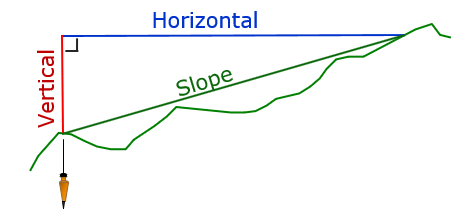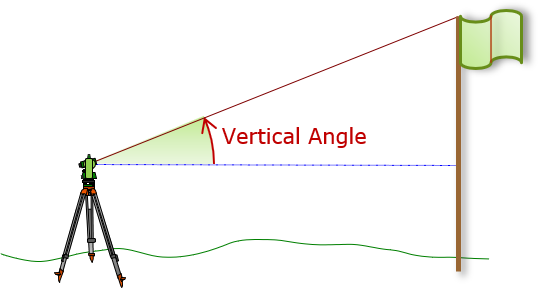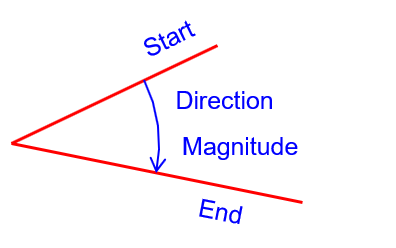{KomentoDisable}
D. Dimensions and Units
1. Definitions
A dimension describes a physical or scientific characteristic of something such as:
-
Length or Distance (including length-based area, volume)
-
Mass
-
Force
-
Temperature
-
Time
A unit is a dimension’s division of measurement. For example:
| Dimension | Units |
| Length | foot, yard, meter, parsec |
| Mass | ounce, gram |
| Temperature | °F, °C |
| Time | hour, day, fortnight |
Although there are many dimensions, most survey measurements are angles and distances. With dynamic systems, such as the Global Positioning System, time is another measurement dimension. Combining measurements and computations allows determination of other dimensions such as velocity, energy, etc.
2. Dimensions
a. Distance
Distances in surveying may be measured in horizontal, vertical, or slope directions, Figure D-1.
|
|
|
Figure D-1 |
Generally the result of a distance measurement is expressed either as a horizontal or vertical value.
In addition to orientation, a distance has a begin, end, and magnitude. All must be either expressed or implied by the type of distance to avoid ambiguity. For example when I stated my height:
-
orientation: vertical implied
-
begin: floor implied
-
end: top of my head implied
-
magnitude: 5’11”
b. Angle
Angles are measured in a vertical or horizontal direction, Figure D-2; slope angles aren’t intentionally measured.
|
|
|
(a) Vertical |
|
|
|
(b) Horizontal |
|
Figure D-2 |
Along with its orientation, an angle has four parts, Figure D-3:
|
|
|
|
Figure D-3 |
3. Units
The Metric (mks: meter-kilogram-second) and English (fps: foot-pound-second) systems are both used for surveying measurements. The English system is used extensively in the US, the primary exception being control surveys which use metric for distances. Although there has been (slooow) progress toward US metric system adoption, there are a number of obstacles inside and outside surveying. The purpose here is not to argue the superiority of one system over the other but to identify within each typical units used for surveying measurements and how to convert between systems.
Unless otherwise specified, all conversion factors shown here are exact.
a. Distance, Area, Volume
Tables D-1 and D-2 list commonly used distance (and area and volume) units for the metric and English systems.
| Table D-1 | |
|
|
Metric Unit (abbr) |
|
Length |
meter (m) 1 m = 100 centimeters (cm) 1 m = 1000 millemeters (mm) 1 kilometer (km) = 1000 m |
|
Area |
square meter (sq m) 1 hectare = 10,000 sq m |
|
Volume |
cubic meter |
| Table D-2 | |
|
|
English Unit (abbr) |
|
Length |
foot (ft) 1 ft = 12 inches 1 yard (yd) = 3 ft rod = pole = perch = 16.5 ft 1 chain (ch, gunter) = 66 ft = 100 links (lk) = 4 rods 1 chain (ch, engineers) = 100 ft = 100 lk 1 mile = 80 ch (gunter) = 5280 ft |
|
Area |
square foot 1 acre = 43,560 sq ft |
|
Volume |
cubic foot 1 cubic yard = 27 cubic ft acre-foot |
Chains
The gunter chain is an important traditional measurement unit in American Surveying. The chain is just that: a chain consisting of 100 links (lk), Figure D-4. Each link is 66 ft/100 lk = 0.66 ft/lk = 7.92 inches. Since there are 100 links in a chain, a distance can be expressed either as decimal chains or mixed units. For example: 3 ch 12 lk is the same as 3.12 ch
|
|
|
Figure D-4 |
Some contemporary units are based on the gunter chain: 1 mile = 80 ch, 1 acre = 10 chains squared. Minimum road widths are often 66 ft (aka, four rod road) with some frontage widths at 49.5 ft (three rods or 3/4 chain).
An engineer chain is similar to a gunter chain except that each of its 100 links are 1 foot long. It was not as universally used as the gunter chain, particularly in land surveys. It was an evolutionary step to the 100 foot steel tape which itself is often referred to as a chain.
For the remainder of this topic when chains are used it will mean gunter chains.
Acre-foot
An acre-foot is the volume created by a one acre area that is one foot deep, Figure D-5. It is used in hydrology where large quantities are involved such as reservoir volumes.
|
|
|
Figure D-5 |
English-metric conversion
In 1791 the meter was defined as 1/10,000,000th of the distance from the North to South Poles along the meridian through Paris. Consider the arduousness of the task of not only determining locations of both poles but accurately measuring the distance between them along a specific meridian given the time frame. To ensure that any country adopting the meter used the same standardized length, in the late 1880s the definition was refined to the distance between two marks on a 90% platinum and 10% iridium bar at 32°F maintained by the International Bureau of Standards and Weights in Paris. Based on that meter definition, the metric-English conversion factor was fixed at 1 meter = 39.37 inches exactly.
In a further bid to define the meter in terms of an easily recreated distance, in 1960 it was set equal to 1,650,763.73 wavelengths of the orange-red emission line in the electromagnetic spectrum of the krypton-86 atom in a vacuum (got that?). In 1983 the meter’s length was again refined, this time as the distance traveled by light in vacuum during a time interval of 1/299792458 second. Based on these last two meter refinements, the English-metric conversion was fixed at 1 inch = 2.54 cm exactly.
While close, these two conversion factors are not exactly the same; there is a difference of about 1/500,000 between the two. For small numbers, that’s not a significant difference, but it can be for larger numbers.
Which to use?
1 meter = 39.37 inches is referred to as the Survey Foot definition
1 inch = 2.54 cm is referred to as the International Foot definition
In surveying we typically use the Survey Foot definition; in Wisconsin it’s actually mandated by law for surveying applications.
Because each is exact, neither introduces error converting metric to/from English unless the wrong one is used.
For example, the Wisconsin South Zone State Plane Coordinates of control point Racine are 82,158.907 meters North and 778,932.458 meters East. These have 8 and 9 significant figures, respectively. Convert these metric coordinates to feet maintaining the same significant figures for each.
Using the Survey Foot definition:
Using the International Foot definition:
The North and East differences are 0.54 ft and 5.11 feet, respectively, both substantial amounts in light of the original coordinates' accuracy. These are errors introduced by using the wrong conversion.
b. Angle
Units and conversion between systems is much simpler for angles than distances. Table D-3 list angular units and their subdivision for both systems.
| Table D-3 | |||
|
System |
Definition |
Subdivision |
|
|
Metric |
Grads |
1 grad = 1/400 circle |
1 grad = 100 centigrads |
|
English |
Degrees |
1 degree = 1/360 circle |
1 degree = 60 minutes 1 minute = 60 seconds |
|
- - |
Radians |
1 radian = circle/(2π) |
|
|
- - |
Mils |
1 mil = 1/6400 circle |
|
Radians are a unitless angular expression used to simplify some calculations; mils are primarily a military angular unit.
Note that a grad is very close to a degree. To give the reader an idea how these units relate to each other, Figure D-6 shows the same angular span divided in degrees, grads, and mils.
|
|
|
Figure D-6 |








